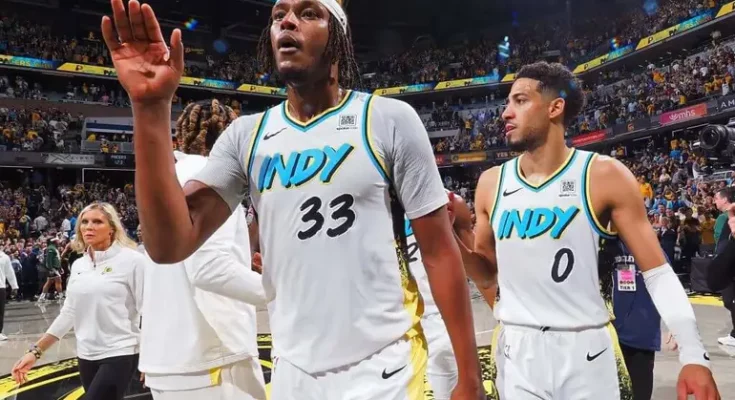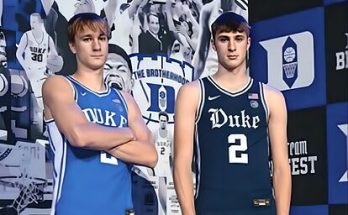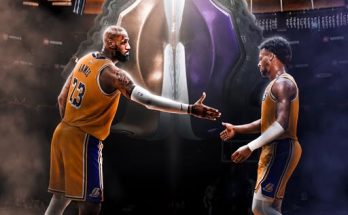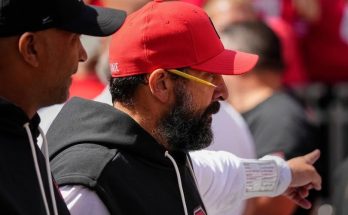When a franchise-altering shift takes place in the NBA, it’s rarely due to a single isolated event. Rather, it’s often the result of a long chain of circumstances, decisions, missteps, and ripple effects. That is precisely the case with Myles Turner’s surprising departure from the Indiana Pacers to the Milwaukee Bucks. On the surface, it reads like just another free agency move in an offseason of star-studded musical chairs. But beneath the surface lies a tangled web of internal confusion, missed opportunities, and external pressures that led to one of the most chaotic off-court collapses in recent Pacers history—a series of dominoes that started wobbling long before Turner inked his new deal.
Myles Turner had been a cornerstone of the Indiana Pacers franchise for nearly a decade. Drafted 11th overall in 2015, Turner quickly established himself as one of the NBA’s premier rim protectors. He was the backbone of the Pacers’ defense, a quietly loyal presence in the locker room, and an outspoken advocate for the city of Indianapolis. Turner was never the flashiest player on the court, but his combination of size, shot-blocking instincts, and an improving perimeter shot made him invaluable in a league rapidly transitioning to floor-spacing big men. He repeatedly expressed his desire to win in Indiana and grow with the team. And yet, here he is now—wearing green and cream instead of navy and gold, suiting up for the Bucks and ready to chase a championship next to Giannis Antetokounmpo.
To understand how such a loyal centerpiece ended up leaving, one has to revisit the series of blunders the Pacers made over the last few years. This was not a move driven by financial greed or personal conflict. This was a textbook example of how misaligned vision, poor internal communication, and strategic inconsistency can force a star player to walk out the door.
The writing, in many ways, was on the wall long before the 2024-2025 season began. The Pacers front office, under the stewardship of Kevin Pritchard, had been in a perpetual state of retooling for several years. After trading away Victor Oladipo and Domantas Sabonis—two former All-Stars—they appeared to embrace a rebuild centered around young talent like Tyrese Haliburton and Bennedict Mathurin. Myles Turner, at 28, was caught in the awkward middle ground: not old, not young, but experienced enough to still contribute to a win-now core, and young enough to grow with a rising team. Instead of committing fully to Turner as a franchise anchor or flipping him for future assets during his peak value, the Pacers hedged their bets.
What followed was a sequence of confusing roster moves and identity crises. In 2023, the team flirted with contending for a playoff spot, showing promise behind Haliburton’s All-Star-level play and Turner’s elite interior defense. But then came a wave of inconsistent performances, injuries, and a defensive collapse that exposed the team’s flaws. Rather than regroup strategically, the front office made short-sighted trades that only deepened the confusion. Adding fringe veterans and marginal bench depth, they continued to teeter on the line between rebuilding and competing, never truly doing either effectively. For Turner, a player who had already spent nearly a decade in the league, patience began wearing thin.
By early 2025, Turner had made it clear through both his agent and subtle comments in interviews that he wanted clarity. Was Indiana building a team that could win in the next two years? Or was this a five-year plan, in which case his prime would be wasted on developmental growing pains? The Pacers, unfortunately, couldn’t provide a coherent answer. And that was the first domino to fall. Uncertainty breeds restlessness. Turner wasn’t demanding a trade. He wasn’t stirring drama behind the scenes. He just wanted purpose, direction, and a plan that matched the urgency of his timeline.
The second major domino came at the trade deadline in February. Rumors swirled that the Pacers were entertaining offers for Turner, mostly from playoff contenders seeking interior defense and spacing. The Bucks, Lakers, and even the Mavericks reportedly called. However, the Pacers set an absurd asking price—perhaps out of fear of fan backlash or simply out of miscalculated leverage. No deal was made. But the damage was done. Turner had been put on the trade block for the third time in four seasons. Every time the front office denied shopping him, leaks would contradict them days later. Turner, who had remained loyal to Indiana despite multiple regime changes, now found himself wondering why that loyalty was not reciprocated.
Domino three arrived in the form of Haliburton’s extension—while deserved—changing the dynamic of the locker room. With a max contract now attached to a rising star guard, the team’s identity shifted overnight. Haliburton was now the face of the franchise, and everything would revolve around his development. While Turner had no problem with the young guard’s ascension, it subtly changed his role from being a co-leader of the team to a supporting veteran. There was no clear conversation about what that meant for his minutes, his involvement in closing lineups, or his long-term role. Miscommunication reigned once again.
Then came the free agency strategy meetings in June. According to multiple reports, Turner had a sit-down meeting with the Pacers’ brass, during which he asked for a transparent breakdown of what direction the team was taking. In private, Turner felt the team was still rudderless. One source close to the situation described it as “a meeting where the front office tried to convince Turner of a plan that even they didn’t fully believe in.” It was clear that Haliburton, Mathurin, and Jarace Walker were the new focal points. Turner, despite his impact on both ends of the floor, had become an afterthought in the future blueprint.
The Bucks, meanwhile, had been watching closely. Their own roster had taken a slight step backward after a disappointing playoff exit in 2025, but their need for a new defensive anchor was obvious. Brook Lopez was nearing the end of his career. Bobby Portis had failed to hold up defensively in high-leverage games. Giannis needed someone next to him who could stretch the floor and provide elite rim protection without clogging the lane. Turner fit that mold perfectly. And, crucially, he was a free agent.
Milwaukee offered something Indiana could not—clarity, championship contention, and a defined role. Turner would not only start, but also be a key cog in a defensive scheme designed to maximize his strengths. He wouldn’t have to question his place. He wouldn’t have to babysit a rebuilding team. He wouldn’t be dangled in trade rumors every February. He would, simply, be valued.
It wasn’t an easy decision for Turner. He loved Indianapolis. He built roots in the community. He often said he wanted to be the rare player who stayed with one team for his entire career. But after years of organizational dysfunction, he made the decision every professional athlete dreads: to walk away from comfort in search of something more meaningful.
And so, Turner signed with the Milwaukee Bucks in early July, shocking casual fans but not those who had paid attention to the undercurrents brewing for years. He left behind a Pacers team still stuck in the “almost-there” phase of development and joined a Bucks team that immediately leapfrogged back into title contention. His addition addressed multiple glaring holes in Milwaukee’s system—allowing Giannis to roam more freely on defense, giving Damian Lillard a pick-and-pop threat, and reinvigorating a locker room that had felt stale post-Lopez era.
In his introductory press conference with the Bucks, Turner was respectful but noticeably pointed. “Sometimes you give everything to a place, and it’s just time,” he said. “I have nothing but love for Indiana. But at this point in my career, I’m ready to win. And I’m ready to be part of something clear, something stable.”
His words were not a jab—they were a diagnosis. The Pacers had fumbled a generational defender, a stretch five who could’ve aged gracefully into a franchise legend. Instead, they forced him to endure years of strategic whiplash, front-office flip-flopping, and an endless cycle of ‘maybe next year.’ While the Haliburton-led future may still be bright, Indiana’s inability to effectively integrate Turner into their long-term vision cost them dearly.
Meanwhile, Milwaukee quietly pulled off one of the most effective signings of the offseason. With Turner, they now possess a modern big who perfectly complements their core and still has several prime years left in his tank. More importantly, they added a player who knows who he is and what he wants—something Indiana could never quite match with a clear direction.
The Turner-Pacers split is a cautionary tale for NBA franchises. Talent isn’t enough. Culture isn’t enough. Even loyalty has its breaking point. When a front office can’t commit to a coherent vision or communicate that vision to its most important players, it creates instability that even good coaching and solid talent can’t fix.
And now, as Myles Turner dons his new jersey, prepares to share the floor with Giannis and Lillard, and steps into a new chapter with championship aspirations, one thing is certain: his departure didn’t happen in a vacuum. It was a slow, grinding, preventable unraveling. And for Pacers fans watching him thrive in Milwaukee next season, the pain won’t come from bitterness—it’ll come from knowing this didn’t have to happen.
Not every breakup is loud. Some are a quiet series of miscommunications, missed signals, and poor timing. Myles Turner leaving Indiana wasn’t a betrayal. It was the inevitable result of a team that didn’t recognize what they had until it was already gone.



